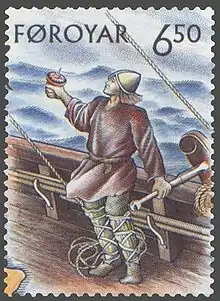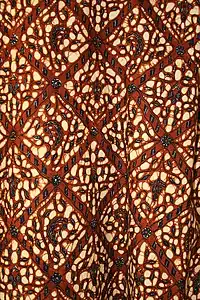Wadmal
Wadmal (Old Norse: vaðmál; Norwegian: vadmål, "cloth measure") is a coarse, dense, usually undyed wool fabric woven in Iceland, Norway, Sweden, Denmark, Greenland, and the Orkney, Faroe and Shetland Islands from the Middle Ages into the 18th century. Wadmal was woven on the warp-weighted loom used throughout these areas of Norwegian influence, and was usually a 2/2 twill weave, although some medieval sources outside Iceland describe wadmal as tabby or plain-woven. In remote regions, wadmal remained the primary fabric for working people's clothing into the 18th century.[1][2]

Wadmal was a medium of exchange throughout Scandinavia. Wadmal was accepted as currency in Sweden, Iceland, Shetland, and Ireland, and exchange rates defined the equivalent of various grades of wadmal (measured in ells) in silver and in cows.[1][2][3] According to Bruce Gelsinger, the term watmal was known in Germany and the southern Baltic region as a rough cloth primarily used by the poor.[4]
Wadmal in Iceland
Wadmal was the main export of Iceland, where length, width, thread count, and weight for different grades were fixed by law.[5] Iceland was also the largest producer of wadmal in the North Atlantic.[6] Producing and selling inadequate wadmal was punishable by law in Iceland; for instance, in Ljósvetninga Saga, one individual is outlawed for selling wadmal full of holes.[4] Wadmal was a dominant form of legal currency in Iceland – both within Iceland and to some extent in the Icelanders’ foreign trade - from the 11th (at the earliest) to 17th century (at the latest).[4][7] According to archeologist Michele Hayeur Smith, wadmal was significant enough in Iceland “that its production nearly eliminated other textile types from the island’s woven repertoire.”[4] Some have argued that, given the importance of wadmal in Iceland and the fact that women primarily produced it, that gender relations in Iceland may have been more equal than was previously thought: "making vaðmál was making money and this may have provided women with a source of power that was socially understood, as the weavers knew best the differences between good and poor-quality vaðmál. This seeming symbiosis may stem from the small size of the Icelandic colony, the harsh nature of the North Atlantic environment and the need for collaboration between the sexes to guarantee survival. This is not to say that resistance did not exist, but it may have been subtle and reflected in the values and symbolic associations connected to the making of cloth".[4]
See also
References
| Look up wadmal in Wiktionary, the free dictionary. |
- Crawford, Barbara E.; Smith, Beverley Ballin (1999). The Biggings, Papa Stour, Shetland: the history and excavation of a royal Norwegian farm. Edinburgh: Society of Antiquaries of Scotland; Der Norske Videnskaps-Akademi. pp. 201, 265. ISBN 978-0-903903-15-8. Retrieved 19 April 2010.
- Østergård, Else (2004). Woven into the Earth: Textiles from Norse Greenland. Aarhus University Press. pp. 62–64. ISBN 978-87-7288-935-1.
- Allen, Larry (2009). The Encyclopedia of Money (2 ed.). ABC-CLIO. p. 73. ISBN 978-1-59884-251-7. Retrieved 22 April 2010.
- Smith, Michèle Hayeur (2013-12-01). "Thorir's bargain: gender, vaðmál and the law". World Archaeology. 45 (5): 730–746. doi:10.1080/00438243.2013.860272. ISSN 0043-8243.
- Pulsiano, Phillip; et al., eds. (1993). Medieval Scandinavia: An Encyclopedia. Garland Press. p. 99. ISBN 9780824047870. Retrieved 22 April 2010.
- Øye, Ingvild (2016). Turner, V.; Owen, O.; Vaugh, D. (eds.). "Tools and Textile Production in the North Atlantic". Proceedings of the 17th Viking Congress.
- Smith, Michele Hayeur (2015). Huang, Angela Ling; Jahnke, Carsten Jahnke (eds.). "Weaving Wealth: Cloth and Trade in Viking Age and Medieval Iceland". Textiles and the Medieval Economy: Production, Trade, and Consumption of Textiles, 8th–16th Centuries. 16. JSTOR j.ctvh1dm0t.5.


.svg.png.webp)